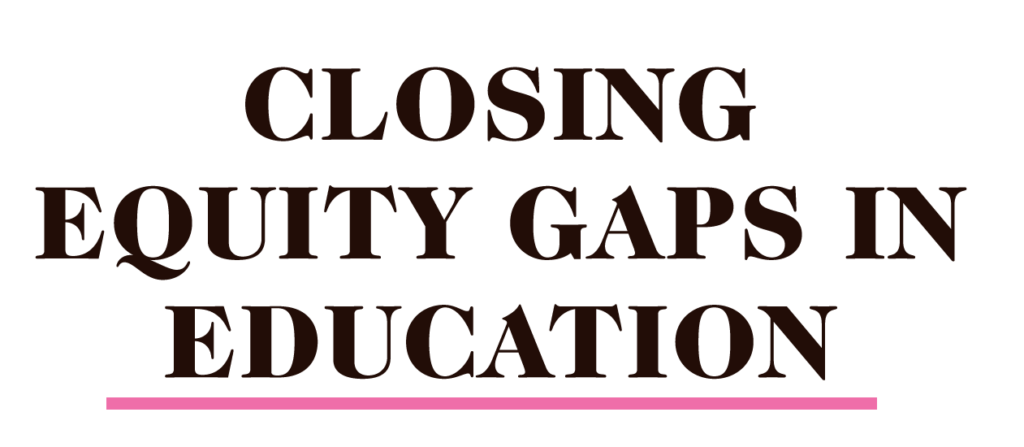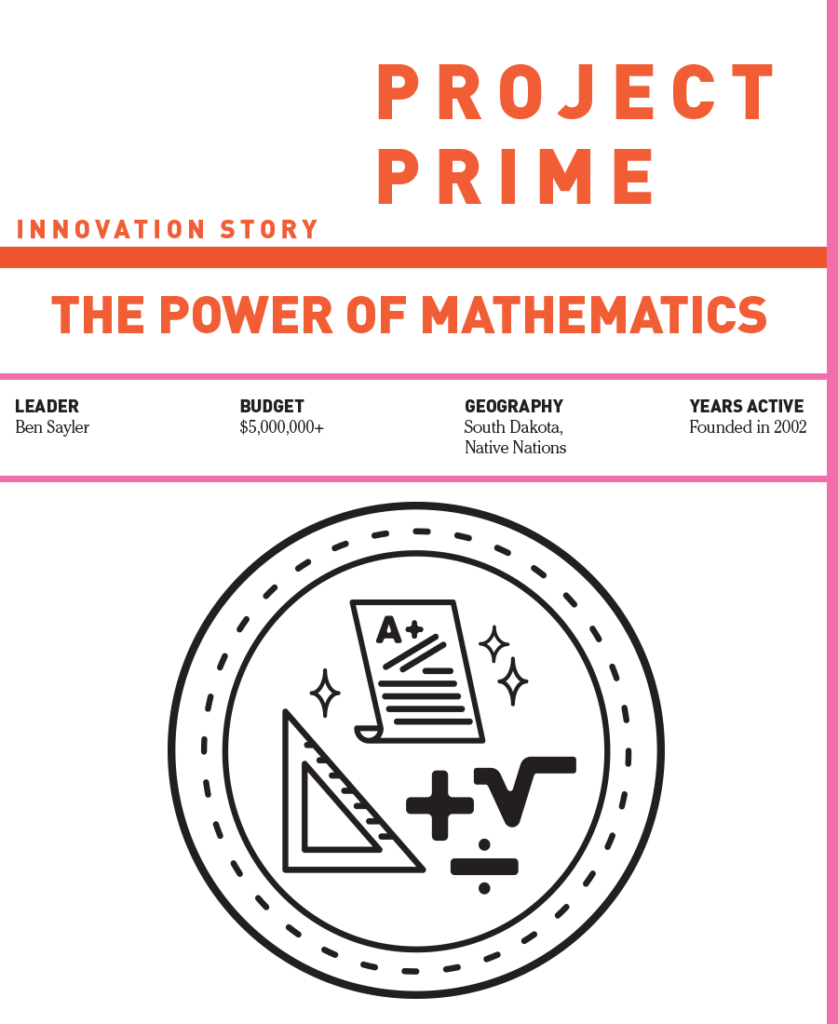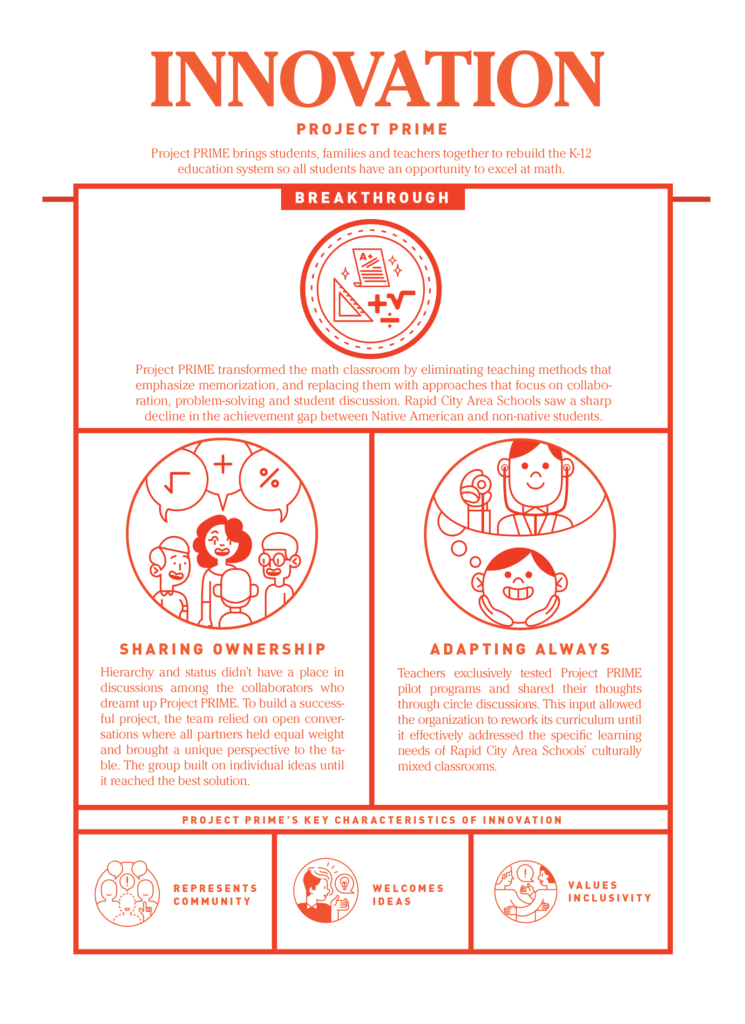
Project PRIME transformed the math classroom by eliminating teaching methods that emphasize memorization, and replacing them with approaches that focus on collaboration, problem-solving and student discussion. Rapid City Area Schools saw a sharp decline in the achievement gap between Native American and non-native students.

Project PRIME is a recipient of the Bush Foundation’s Bush Prize for Community Innovation.

FOUR TIMES PER YEAR, students and parents from Rapid City Area Schools filter into brightly lit class-rooms for Family Math Night. Students look forward to showing off their math skills to parents through games like “Fraction Tracks” and “Big Array, Small Array.” Huddled over games teachers created out of paper and markers, the children’s concentrated faces break into smiles when they discover solutions. Ben Sayler, a physical sciences and mathematics professor and the principal investigator for Project PRIME, is proud that Project PRIME brought families, educators and community members together under one common vision: uplift standards for math instruction at the K-12 level so all students have equal opportunity to excel.
Ben Sayler is especially proud that the team behind Project PRIME helped to bridge the math proficiency gap between Native American and non-native students. “Being successful in mathematics is a power,” Ben said. “Students who are successful in mathematics can see opportunities to go into a lot of fields that would be completely closed to them otherwise.”

It was a select few students who were succeeding in math, and a select few students who enjoyed math,” said Ben. “It was important to the partners to figure out a way to change that and break that pattern.”
The team suspected the disparity could be attributed to the fact that institutional teaching methods failed to incorporate Native American traditions in learning. But before advocating for an enhanced approach, the team needed to know more. So the Project PRIME team went straight to their most important allies and listened hard. They knew they couldn’t succeed without proper engagement from students, parents and educators.
Project PRIME organized roundtable discussions where students could share their thoughts. The team gathered groups of five to eight volunteers, from varying backgrounds, and asked them to sit in a circle to share feedback. When students answered vaguely in response to questions about their academic experiences, Project PRIME probed deeper or held one-on-one meetings with students to gather accurate and in-depth perspectives. By tracking students’ answers closely, Project PRIME identified patterns. One important pattern emerged: struggling students didn’t respond to the tradition of memorizing and applying formulas and equations. They learned better through class conversation and group methods. Project PRIME took this information and began to craft a plan to revamp the math system in K-12 schools.
The focus group findings led Project PRIME to recommend a new approach called Cognitively Gathered Instruction (CGI)—a teaching method that emphasizes teamwork and storytelling as strategies for problem-solving. For Lakota students who grew up hearing elders tell stories as a way to impart advice and life lessons, CGI was a more natural fit to learn math compared to passively memorizing multiplication tables and formulas. With CGI, Rapid City schoolteachers turned math into an adventure and its students into creative explorers.

Project PRIME wanted to gather more input on what changes to make, so it hosted a summit in the Black Hills. Through a roundtable model, the team invited parents, educators, local leaders and national experts to dig into how Native American students best learn math. Throughout several days, participants expressed their concerns about math education and ideas for solutions. By the end of the summit, collaborators agreed that methods benefiting Native American students would likely lead to improved math instruction for all students who struggled in the classroom. With that, RCAS began an aggressive campaign to adopt an inquiry-based teaching style, abolishing traditional methods that taught kids there was only one way to solve a problem. Teachers encouraged students to ask questions and discover multiple ways to find a solution.
Through humility and a willingness to listen, Project PRIME finally reached an accordance between learning institutions, educators and parents. The schools would adopt a new math learning system that focused on students building mathematical ideas for themselves and working collaboratively with one another, in the hopes that Native American and non-native students would succeed equally.


Traditionally, K-12 and higher education found themselves somewhat at odds with one another. “Often the issue is that higher education comes to the table thinking that they can fix something, and that K-12 is the thing to be fixed,” Ben said. Despite that history, a common vision to boost math skills in Rapid City brought the two groups together. What kept them together was an acknowledgment from both parties that each could do more to improve the problem.
“Mutual respect and hard work were necessary,” said Maggie Austin, a Project PRIME partner and member of the Technology and Innovation in Education team. “People needed to bring forward humility and a belief that the whole was bigger than the parts. Nobody posed as an expert. They knew they were going into new territory and needed everyone’s good thinking.”
In addition to open communication among team members, Ben attributed Project PRIME’s success in part to the existing culture in South Dakota: “People don’t concern themselves as much with status and hierarchy. We just pick up the phone and call the people we need to help move our work forward.” That attitude allowed the team to overhaul a system burdened by lackluster K-12 math instruction and swap it for new protocols that RCAS teachers and BHSU student teachers now follow. It’s an institutionalized change that not only benefited Rapid City schools, but the entire state of South Dakota.


Teachers were vital sources of input to the ever-adapting Project PRIME approach. Instead of hiring outside consultants, Project PRIME relied heavily on teachers within the system to test pilot programs and share their feedback. Family Math Night brought families together, but Project PRIME also saw it as an opportunity for students to help them bring one of the initiative’s most important goals to life—showing parents the benefits of the new approach. Test results and summaries gave parents an overarching idea of Project PRIME’s success, but having students teach parents the math games they play at school every day succeeded in garnering parents’ enthusiasm. The games were so simple that students could make the materials out of paper and markers at home—and they did, extending Family Math Night into other nights of the week inside their living rooms.
The project led to powerful results. Between 2003 and 2013, there was a 28 percent increase in RCAS students who were “proficient or advanced” in mathematics. The achievement gap between Native American students and other RCAS students also decreased from 37 percent to 21 percent. Ben has summed up Project PRIME’s efforts and success by pointing to its efficient approach: “We had a mentality of ‘get it going, get it good, get it institutionalized.’” Over time, Project PRIME proved that a systems approach is the most effective way of addressing the specific learning needs of its culturally mixed classrooms.

Now, classrooms are filled with students excited to solve math problems. Imagine how those problem-solving skills will shape South Dakota’s future innovations.


Produced in partnership with the Bush Foundation
to showcase the culture of innovation
behind its Bush Prize winners.
Contributors




